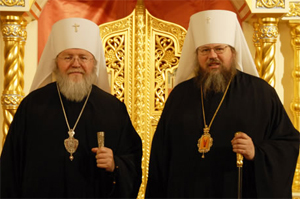
NEW YORK: December 10, 2011
Statement by the Synod of Bishops
 Since the normalization of ties between the Russian Orthodox Church Outside of Russia and the Moscow Patriarchate in 2007, there have been numerous concelebrations between ROCOR and the Orthodox Church in America, including some at the hierarchical level. This year is marked by the first two concelebrations between the First Hierarchs of the Church Abroad and the Orthodox Church in America, and we state the following, in response to questions by the clergy and faithful: Since the normalization of ties between the Russian Orthodox Church Outside of Russia and the Moscow Patriarchate in 2007, there have been numerous concelebrations between ROCOR and the Orthodox Church in America, including some at the hierarchical level. This year is marked by the first two concelebrations between the First Hierarchs of the Church Abroad and the Orthodox Church in America, and we state the following, in response to questions by the clergy and faithful:
The Russian Orthodox diocese in the New World was formed in Alaska, while Alaska was still part of the Russian Empire, in 1795. In the following century, after the United States obtained Alaska from Russia, more and more Russian Orthodox parishes were formed in the continental US, and the seat of the diocese, which eventually was to become a Metropolia, was moved to New York. The seizure of power by the Bolsheviks in 1917 made administration from Russia virtually impossible, and from 1921, with the formation of the Church Abroad administration in Yugoslavia, the American Metropolia was considered part of the ROCOR.
However, relations with the rest of the Church Abroad were complicated by the difference in background of those who had come to the United States before and after the Revolution: the earlier emigres had moved to America seeking a better life and a permanent new home, while those who fled from the communists had a strong attachment to Russia and in most cases, hoped to return one day, when the political situation there would change.
In 1925, Holy Patriarch Tikhon reposed after years of persecution by the Bolsheviks, and in the same year, the "Living Church" or "Renovationists" led by Alexander Kedrovsky, managed to gain control of St Nicholas Cathedral in New York City, winning a court case against Metropolitan Platon (Rozhdestvensky). The court found in favor of Kedrovsky, on the grounds that his group was "under a Holy Synod of Russia," but the Church Abroad was not. The death of Patriarch Tikhon also removed a unifying figure, and these factors and others led to a division between the American Metropolia and the Church Abroad. Despite a period of reconciliation from 1935 to 1946, the Metropolia and Synod separated again, largely over relations with the Church in Russia.
The reconciliation in 2007 between the Church Abroad and the Moscow Patriarchate removed the main point of dissention between the two jurisdictions.
At that time, each side lifted the disciplinary suspensions that had been placed on clergy for joining the other. This meant that the canonical obstacles to concelebration had been rectified, and clergy from each could concelebrate with the other. Regardless of that, differences in the points of view and traditions between the Russian Orthodox Church Outside of Russia and the Orthodox Church in America are possible: they have occurred more than once in history between Orthodox hierarchies, and do not have any bearing on official relations. Meanwhile, in 1970, the Moscow Patriarchate had by its own initiative, unilaterally granted the title of "autocephaly" to the former American Metropolia, which changed its name to the "Orthodox Church in America". The full logical consequences of autocephaly would have been a single, canonical hierarchy for that given area, but this was never accepted by the other Orthodox Local Churches, most of which continued, and still continue, to have their own hierarchies in the United States. Nonetheless, the current situation does not constitute an obstacle to communion between the Orthodox Churches here.
ROCOR has always claimed to be only one part of the Church of Russia, and not to be “the Church of Russia in Exile”—a Church of Exiles, at its inception, but not the Church in exile. This has always been confirmed by the decisions of the Bishops’ Councils. The Church Abroad has never claimed to be the only canonical Orthodox Church, or that the various Local Churches are not canonical Churches. ROCOR remains committed to its conservative, traditional positions, and so does the Moscow Patriarchate. Therefore we are not compromising any principles by normalizing relations with the rest of the Orthodox Church.
The Church Abroad was formed for the purpose of uniting the Russian communities outside of Russia, who desired to remain faithful members of the Orthodox Church of Russia, awaiting its revival, and from the beginning also carried on the missionary function of spreading the Orthodox faith among non-Russians, wherever possible. These roles remain unchanged.

|